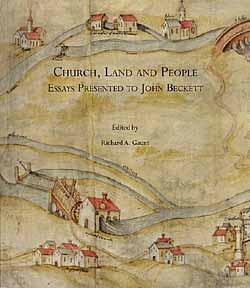Thoroton Society Record Series
Thoroton Society Record Series, Volume 50 (2020) Church, Land and People : Essays Presented to John Beckett, edited by Dr Richard Gaunt. 274 pp. ISBN 978-0-902719-28-6.
 |
The Thoroton Society has honoured one of the most distinguished historians of Nottinghamshire and one of the society’s longest-serving officers in the latest volume in its Record Series. Church, Land and People. Essays Presented to John Beckett has been published to coincide with John’s 70th birthday and commemorates his retirement as Chair of the Society’s Council after 28 years and as Professor of English Regional History at the University of Nottingham after 30 years.
John’s academic career, which began in 1975, has been particularly associated with the county. He joined the academic staff at Nottingham in 1979 and has established himself as one of the most influential and accessible of the county’s historians. In addition to academic work on agrarian life and rural history, John has researched and published on projects concerning parliamentary enclosure, local politics, church history, landed estates and their owners, the Green Spaces of Nottingham, and, most recently, the ‘hidden histories’ of the First World War. He was responsible for editing the Centenary History of Nottingham (1997), which commemorated the award of city status to Nottingham in 1897 and is acknowledged as the pre-eminent historian of Laxton, the last village in the country to use the open-field system. His definitive one-volume history of the University of Nottingham was published in 2016. He has been an active presence in the local history community, through talks, presentations, and media appearances, for forty years, and influenced generations of local historians through the MA in Regional and Local History, which he co-founded with colleagues in the Department of Continuing Education at Nottingham in 1983. John also served as Director of the Victoria County History between 2005 and 2010 and, in combination with the Thoroton Society, was instrumental in re-launching work in Nottinghamshire.
Church, Land and People is the 50th volume in the Society’s Record Series. It brings together essays from a range of those with whom John has collaborated as teacher, mentor, supervisor, researcher, author, colleague, coadjutor, and friend, on topics relating to the history of Nottinghamshire. The chronological range of the volume largely mirrors that with which John’s academic career has been concerned, from the mid-17th century onwards, and comprises a suitably wide range of subjects, including great estates (Welbeck Abbey), important towns (Norwell, Newark, Bingham), important themes (coaching and communications), and people (including aristocratic women and rebellious men). The volume’s title hints at three of the larger themes in John’s output as a historian – Church, Land and People – and pays tribute to a man whom Sir Neil Cossons describes in the foreword to the volume as ‘an enlightening and amiable companion’.
Contents
Foreword by Sir Neil Cossons, xii-xiii
Introduction by Richard A. Gaunt, 1-17
Martyn Bennett, 'Regionalism and localism: conflict and war in the Midlands, 1642-48', 19-30.
David Crook, 'Nottingham, Robin Hood, and the Coronation of Charles II', 31-35.
Trevor Foulds, ''Nothing less than a Duke' : Henry 2nd Duke of Newcastle and the marriages of his daughters', 37-50.
Michael and Elizabeth Jones, 'Life in a Nottinghamshire parish, c.1664-1725 : The churchwardens of Norwell and their accounts', 51-74.
Philip Riden, 'Early post in Derbyshire and Nottinghamshire: evidence from the archives at Chatsworth', 75-95.
Stanley Chapman, 'Newark as a coaching centre, c.1600-1850', 97-114.
David Marcombe, ‘Cranmer Kenrick: Merchant and Patriot’, 115-129
Dorothy Johnston, 'A work in progress : Early developments at Welbeck Park by the 3rd Duke of Portland', 131-147.
Richard A. Gaunt, 'Trials and the retribution: the fate of the Pentrich Rebels', 149-169.
Adrian Henstock, 'From Georgian laxity to Victorian values? Social and economic change in two East Midland market towns during the 1840s', 171-188.
Ken Brand, 'The making of 'New Nottingham': enclosure and architecture in the 1850s', 189-208.
Christopher J. Brooke, 'Discovering groups in ecclesiastical data: the use of cluster analysis in the Southwell and Nottingham Church History Project', 209-228.
Michael Turner, 'In search of the Nottinghamshire yeoman', 229-246.
Picture Gallery, 261-264
Index, 265-274
Please see the Ordering Thoroton Society publications page for information on purchasing Record Series volumes.